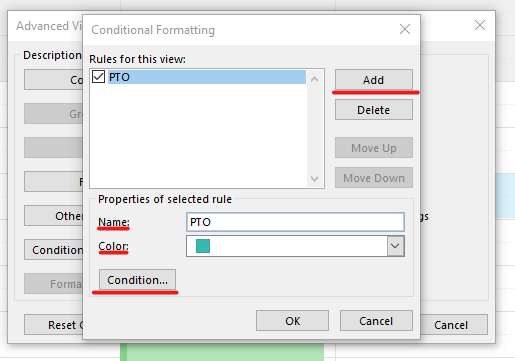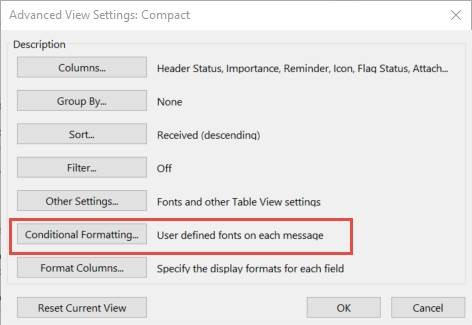
- Outlook conditional formatting group policy how to#
- Outlook conditional formatting group policy full#
You enter a reference to your first cell with a date, B$5 in our case. The serial_number parameter represents the date you are trying to find.Now, let me briefly explain the WEEKDAY(serial_number,) formula so that you can quickly adjust it for your own spreadsheets. When done, click the OK button to preview the rule. Click the Format… button and set up your custom format by switching between the Font, Border and Fill tabs and playing with different formatting options.In the " Format values where this formula is true" box, enter the following WEEKDAY formula that will determine which cells are Saturdays and Sundays: =WEEKDAY(B$5,2)>5.
Outlook conditional formatting group policy how to#
Outlook conditional formatting group policy full#
From the drop-down list under Type, select either dddd or ddd to show full day names or abbreviated names, respectively. If you want to display only the days of the week like you see in the image above, select the cells with the formula (row 5 in our case), right-click and choose Format Cells…> Number > Custom. I used the formula =DATE($B$2,$B$1,B$4) which is copied across row 5. The screenshot below demonstrates the DATE function in action. Of course, you could type the numbers directly in the formula, but this is not a very efficient approach because you would have to adjust the formula for each month. Simply enter the year and the month's number somewhere in your spreadsheet and reference those cells in the formula. When designing your Excel calendar, you can use the =DATE(year,month,date) function to display the days of the week. Well, let's see how you can create your own automated calendar with quite little effort. Regrettably, Microsoft Excel does not have a built-in calendar similar to Outlook's. Below you will find a few examples of my favorite Excel conditional formats for dates. more than a month from the current date), you will have to create your own conditional formatting rule based on a formula. If you want to highlight cells or entire rows based on a date in another cell, or create rules for greater time intervals (i.e. Excel conditional formatting formulas for dates However, this fast and straightforward way has two significant limitations - 1) it works for selected cells only and 2) the conditional format is always applied based on the current date. If the Excel standard palette does not suffice, you can always click the More colors… button.

Excel conditional formatting date formulas.



 0 kommentar(er)
0 kommentar(er)
